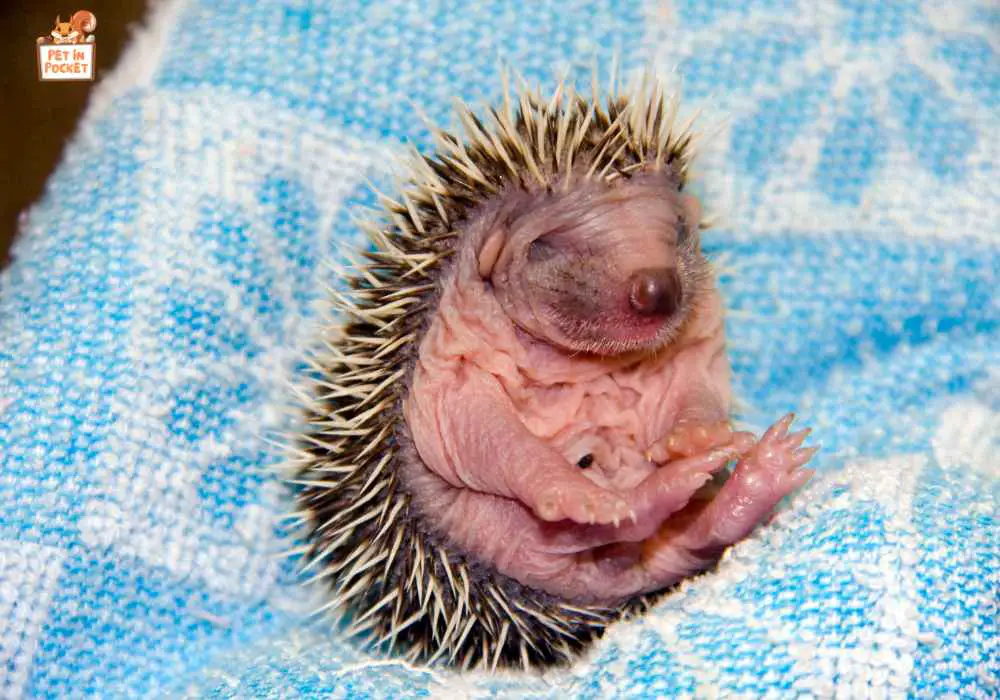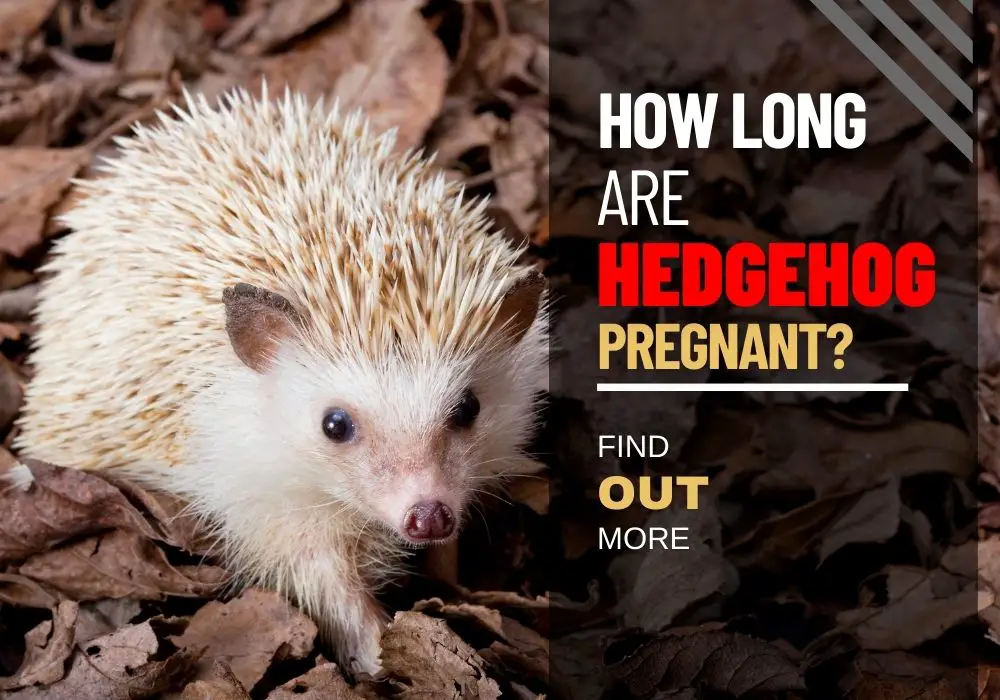When people think about hedgehogs having babies, they often wonder: How long are hedgehogs pregnant?
The gestation time, or length of pregnancy, is a little different for each type of hedgehog. It takes the wild hedgehog about 30 to 40 days to give birth. The African hedgehog, which is often kept as a pet, gives birth to babies every 36 days.
The European hedgehog, which lives all over Europe, has a slightly longer gestation phase, lasting an average of 37 days. These times show how fast hedgehogs’ gestation periods are. This lets them have babies quickly, which increases their chances of living as a species.
Table of Contents
The Hedgehog Mating Season
Hedgehogs’ mating season is an exciting part of their life cycle because it depends on where they live and what type they are. It is thought that hedgehogs mate during the warmer months, usually spring and summer.
Timing:
Many temperate hedgehog species mate in early spring and summer. During this time, species that rest, like the European hedgehog (Erinaceus europaeus), emerge from their winter sleep. These months are great for breeding because the weather gets warmer, and more food is available.
Behavior:
Male hedgehogs seek for females during mating season. Often, this means more action at night, and males may fight over a possible mate, which can make for noisy encounters.
Traditions of Courtship:
The way hedgehogs court is very different from other animals. The males do a complicated, nonstop dance around the female, which is often followed by sounds of snuffling and puffing. These fights can last hours until the female gives in and lets the male in.
Effects of Environment:
If hedgehogs live in cities or are kept as pets, artificial lights, and temperature control can change when they mate. These things can change hedgehogs’ normal breeding cycle by changing when they hibernate and when their hormones cycle.
How to Tell If a Hedgehog Is Expecting

Although hedgehogs are private and often secretive, it can be hard to tell if they are pregnant. But there are a few things that might mean a hedgehog is expecting:
| Weight Gain: | Getting heavy is one of the most obvious signs. As their pregnancy goes on, pregnant hedgehogs will slowly gain weight. |
| Change in hunger: | Your hunger may change in a way you can tell. There is a chance that some hedgehogs will eat more; others may eat less. Hormone changes during pregnancy are to blame for this change. |
| Nesting Behavior: | If a hedgehog is pregnant, it may start to act like it wants to build a nest. This means gathering things like grass, leaves, and fabric to make a nest where she can give birth and care for her babies. |
| Less Activity: | Hedgehogs that are pregnant may move around less. They may move around less and rest more as the pregnancy goes on because of the extra weight and changes in their body. |
| Shape Changes: | The hedgehog may gain weight and also have a change in the shape of its body. As the hoglets get bigger, their bellies may look rounder and more prominent. |
| Changes in Personality: | Some hedgehogs may act or behave differently. They may become more irritated or less willing to talk to people than usual. |
| Changes in the body: | As the pregnancy ends, you may be able to see or feel the hoglets moving inside the mother’s belly. |
How Much Time Does a Delivery Take?
Depending on the type, hedgehogs can stay pregnant for anywhere from 4 to 6 weeks. For example, the pregnancy of the Four-toed hedgehog (Atelerix albiventris) lasts about 35 days on average. In the same way, it takes 30 to 40 days for the Southern African hedgehog (Atelerix frontalis) to give birth. On the other hand, the Western European hedgehog (Erinaceus europaeus) may have slightly more extended breeding periods, sometimes going up to 49 days.
Hedgehog Maturity
It’s interesting to see how hedgehogs grow and reach full age at different times for different individuals. These little animals are usually fully grown when they are 9 to 11 months old, but this can change. Interestingly, both male and female southern African hedgehogs typically reach sexual maturity at about 12 months of age.
On the other hand, European species are usually ready to reproduce around 9 months, which is a bit faster. One notable exception in the hedgehog family is the four-toed hedgehog, which grows quickly. For example, female four-toed hedgehogs can have babies as early as 84 days old.
Besides this, hedgehogs’ surroundings and food can also significantly affect how they grow up. Good eating and a safe, stress-free setting can help kids grow healthier and maybe even faster. Genetics and general health also affect the age at which hedgehogs are ready to reproduce. Understanding these things is essential for anyone who studies or cares for these unique animals.
Pregnancy and Pet Hedgehogs

Recognition of Pet Hedgehog Pregnancy
More and more people are getting hedgehogs as pocket pets. People love them for their unique quills and curious nature. You can also find these animals in the wild, but sometimes they move in with people and become part of the family. Taking care of both male and female hedgehogs means the females might get pregnant. Knowing how to tell if a pet hedgehog is pregnant is essential to ensure it receives the proper care.
An apparent rise in hunger and a slight gain in weight are common signs that a hedgehog is pregnant. These signs are often paired with behaviors like nesting, in which the expecting mother starts making a safe and comfortable space for her babies to come. She can collect furniture and rearrange it to make a good space for giving birth and raising her kid.
Veterinarian Consultation
If you see any of these signs in your female hedgehog, it could mean she is pregnant. It’s best to talk to a vet specializing in unusual animals when this happens. This professional checkup is essential to prove that your hedgehog is pregnant and to ensure it gets the best care possible during this sensitive time.
Care and Management of Pregnancy
It’s also important to know that a hedgehog’s pregnancy lasts 35 to 58 days, in addition to these general signs. During this time, giving the mother hedgehog a stress-free and relaxed place is significant. Stress can happen when her environment changes quickly or when you handle her too much, which could affect the health of both the mother and her future child. While pregnant, the mother’s health and egg development depends on a high-protein diet. A doctor can help you find any health problems early on and ensure your pet hedgehog has a safe pregnancy by checking on it regularly.
What to do once a hedgehog gives birth?
Following your hedgehog’s birth, we have some advice for you. Take a look!
Initial care after birth
In the days after hedgehog babies are born, the main goal should be to cause as little trouble as possible. Let the mother hedgehog bond with her new babies, called hoglets, for the first week without getting in the way. During this time, hedgehogs can be very sensitive, and worry can make the mother reject or even hurt her young. It’s essential to keep a polite space during this important bonding time.
Slowly bringing back
You can get to know the mother hedgehog again after the first week. It is important to be careful during this process and ensure that all moves and actions are soft, quiet, and slow. To keep the mother and her babies from feeling stressed, the goal is to be seen as not a danger.
Maintenance on Enclosures
Cleaning the cage should be done in a way that doesn’t damage it or take too much time. This is done so as not to bother or stress the new mother. To keep the hedgehog family’s surroundings calm and steady, you should avoid cleaning or moving around during this time.
Hoglet’s Growth and Independence

The hoglets start to show signs of freedom as they get bigger. They begin to look around outside their nest at around four weeks old. By seven weeks, they are usually ready to live independently and no longer need their mother to care for them all the time. It’s important to monitor their health and development during this part of growth to ensure they are active and adding weight. If you have any worries about your hedgehog’s health, you should talk to a vet who has experience with them immediately so that the problem can be fixed quickly and correctly.
Conclusion
Finally, getting pregnant and raising babies is over in just a few months, showing how efficient and flexible these small animals are in their reproductive cycle. For the best care of pregnant hedgehogs, giving them a quiet place to live, lots of things to use as nests, and enough food is essential. It’s also important to understand and value their need for privacy now. Caregivers can make a big difference in the health and well-being of the mother hedgehog and her babies by ensuring these things are in place.
FAQ
How many babies do hedgehogs have at once?
Hedgehogs usually give birth to 1 to 7 babies, with an average litter of 3 to 4 hoglets.
What should you do to care for a pregnant hedgehog?
Ensure a nutritious diet, a comfortable nesting area, minimal stress, and avoid handling too much, especially in the later stages of pregnancy.
How does pregnancy affect a hedgehog’s behavior?
Pregnant hedgehogs may become more reclusive, show nesting behaviors, and be less tolerant of handling.
Do mother hedgehogs leave their young after birth?
Mother hedgehogs do not typically leave their young immediately after birth. They usually stay with their hoglets (baby hedgehogs) to nurse and protect them during the initial critical weeks.
When is the best time to breed a hedgehog?
Breeding should be done when the hedgehog is at a healthy weight and age, typically after 6 months old.






Leave a Reply